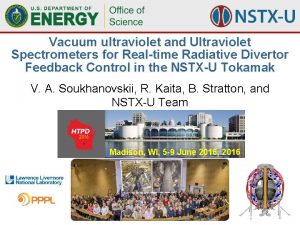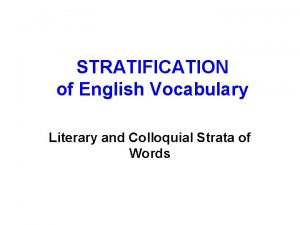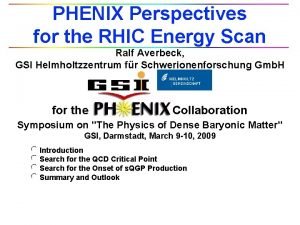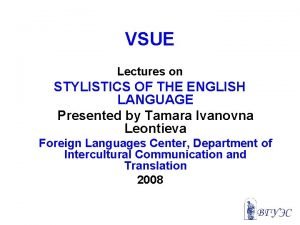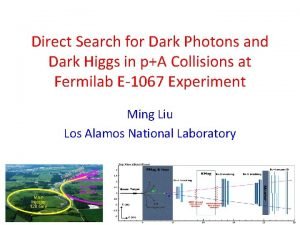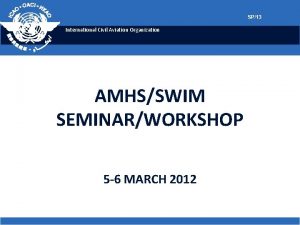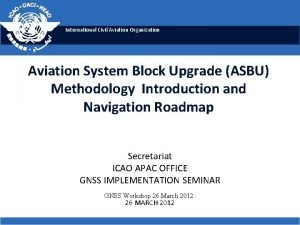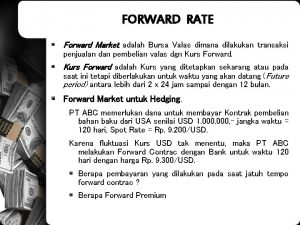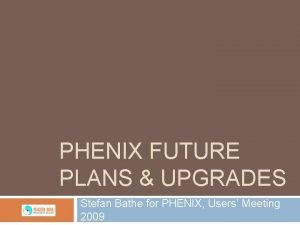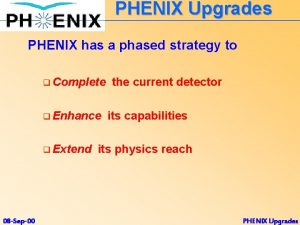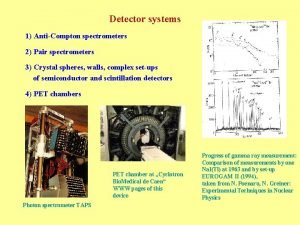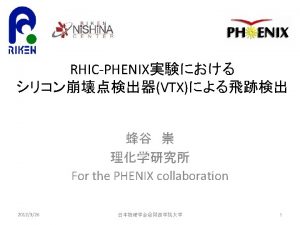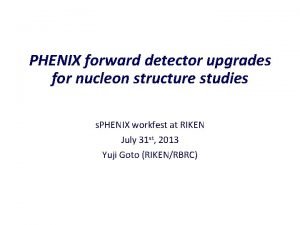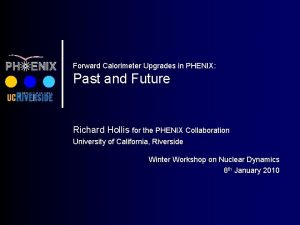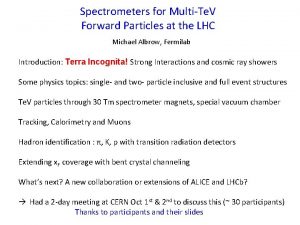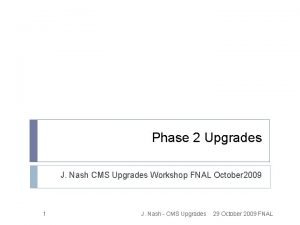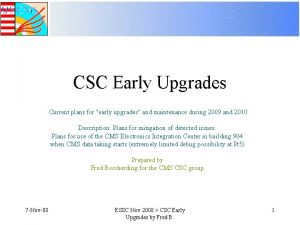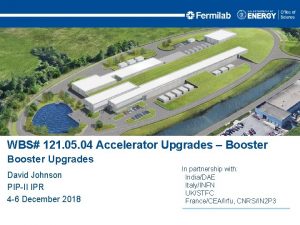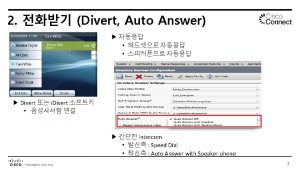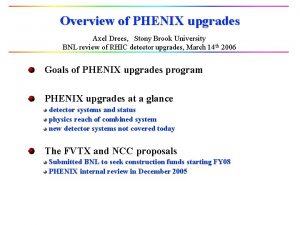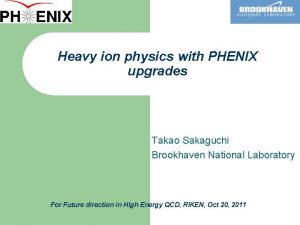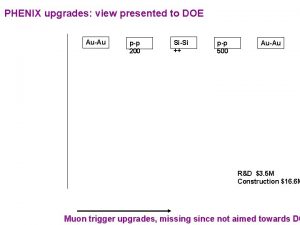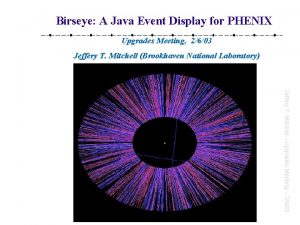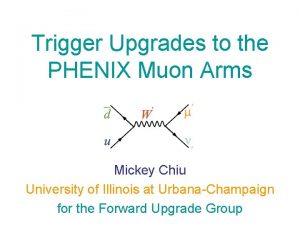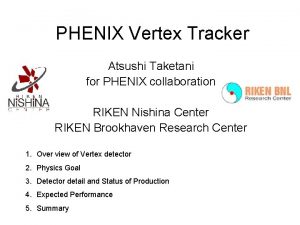Proposed Upgrades for the PHENIX Forward Spectrometers for



























- Slides: 27

Proposed Upgrades for the PHENIX Forward Spectrometers for Spin Physics Edward R. Kinney University of Colorado, Boulder, USA 12 October 2004 SPIN 2004 Trieste

Brookhaven National Laboratory: Edward Kistenev, Peter Kroon, Mike Tannenbaum, Craig Woody University of California at Riverside Ken Barish, Stefan Bathe, Vasily Dzhordzhadze, Tim Hester, Xinhua Li, Astrid Morreale, Richard Seto, Alexander Solin University of Colorado Frank Ellinghaus, Ed Kinney, Jamie Nagle, Joseph Seele, Matt Wysocki University of Illinois at Urbana Champaign Mickey Chiu, Matthias Grosse Perdekamp, Hiro Hiejima, Alexander Linden-Levy, Cody Mc. Cain, Jen-Chieh Peng, Joshua Rubin, Ralf Seidel Iowa State University John Lajoie, John Hill, Gary Sleege Kyoto University Kazuya Aoki, Ken-ichi Imai, Naohito Saito, Kohei Shoji Moscow State University Mikhail Merkin, Alexander Voronin Nevis Laboratory Cheng Yi Chi University of New Mexico Doug Fields RIKEN Atsushi Taketani RBRC Gerry Bunce, Wei Xie University of Tennesee Ken Read Collaboration still forming! . 12 October 2004 SPIN 2004 Trieste

How do quarks and gluons make up the proton spin? • Quark spins? • Quark angular momentum? • Valence vs Sea? • Gluon (spin+angular momentum)? • Gluon Sea Relationship • Scale Invariance of (1/2)h 12 October 2004 SPIN 2004 Trieste

PHENIX Spin Structure Program Using Polarized pp Scattering • Polarized Gluon Distribution • Direct Photon production • Leading Pion production • Open Charm production • and more… • Polarized Quark/Anti. Quark Distributions • Polarized W Production • Transverse Distributions and Physics 12 October 2004 SPIN 2004 Trieste

Spin Structure Motivations for PHENIX Forward Upgrade • Greatly enhance capability to measure quark and anti-quark polarizations via W boson production • Extend range of gluon polarization measurement to smaller x. Bj with additional photon/ 0 acceptance 12 October 2004 SPIN 2004 Trieste

Nuclear Physics Motivation for Forward Upgrade • Study nucleon structure in nuclei at high parton densities in p+A collisions. • Greatly extend acceptance for high p. T jetphoton measurements (jet tomography) in A+A. 12 October 2004 SPIN 2004 Trieste

The PHENIX Spectrometer Muon Arms • Tracking + Mu. ID • 1. 2 < | | < 2. 4 • 2 Azimuthal Acceptance • p 2 Ge. V/c Central Arms • Tracking + RICH + TOF+ EMCal • | | < 0. 35 • Azimuthal Acceptance • p. T 0. 2 Ge. V/c 12 October 2004 SPIN 2004 Trieste

Upgrade Components • Upgraded muon trigger – Add momentum information into muon trigger for highest luminosities in p-p, d-A and A-A – Gives robustness against beam and collision related backgrounds. New trackers x • Nose cone calorimeter – 0. 9 < |h| < 3. 0 (NCC) – Tungsten-Silicon sampling calorimeters – Electromagnetic and shallow hadronic compartment – Expands PHENIX’s kinematical coverage for jets, inclusive neutral pions, electrons, and photons to forward rapidity – For p-p, d-A and A-A collisions. 12 October 2004 SPIN 2004 Trieste Upgraded muon trigger and NCC also on South side

Flavor decomposition with SIDIS lim e pr r ina y • Depends on knowledge of FFs • Difficult to apply full NLO analysis • u quark dominance “hides” d and s 12 October 2004 SPIN 2004 Trieste

Flavor decomposition via W’s with PHENIX Ø The measurement of inclusive single spin muon asymmetries (from W’s) is a new unbiased way to probe Dq/q, Dq/q. Produced in pure V-A – Complete theoretical treatment from first principles by Nadolsky and Yuan using re-summation and NLO techniques [Nucl. Phys. B 666(2003) 31]. Quark helicities fixed – Does not suffer from scale uncertainties ØExperimentally clean measurement. AL –AL is parity violating - no false physics asymmetries. –Does not rely on knowledge of fragmentation functions ØHighest luminosity p+p running at 500 Ge. V required. –Prescale factor of 20 -50 required without muon trigger upgrade. –Significance would go down by prescale factor 12 October 2004 p. Tm SPIN 2004 Trieste

Upgraded muon trigger for W’s » Current muon trigger: – 2. 3 Ge. V “deep” muon – Factor of 20 -50 rejection and robustness to background required for p+p at highest luminosities bottom » Upgrade needed to add momentum information to trigger: – RPC’s for new chambers – Even modest timing information help remove beam related background. – Instrument mu. TR with triggering electronics » Detailed simulations with lookup-table algorithms give specifications: W charm Z – Upstream tracker granularity 10 x 10 cm 2 into lookØ RPC R&D at UIUC and RBRC up table prototype for run 5. – Downstream tracker granularity 30 x 30 cm 2 into Ø Tests/studies at Kyoto and look-up table UNM to instrument mu. TR – f resolution = 1 o 12 October 2004 SPIN 2004 Trieste

DG using the NCC Ø Detection of both hadron jet and final state photon is possible with the NCC and new central arm tracking detectors. – Allows the determination of x. G of the gluon on an event-by-event basis (used in conjunction with silicon vertex) Ø Significantly extends the range of x. G for the prompt- measurement down to ~0. 001 at Ös =200 Ge. V – – Channel with highest analyzing power for gluon polarization in polarized p+p. Sensitivity to shape of polarized gluon distribution over a large x range (important input to extrapolation of DG to low x) GS 95 prompt photon central arms NCC Ø DG with NCC at low-x through jet- , 0, e-m, open charm. 12 October 2004 SPIN 2004 Trieste

Nose Cone Calorimeter Requirements: Ø Good photon measurements Ø Reasonable jet measurements Ø Triggering capability Constraints: » 40 cm from collision point => Silicon pixels » 20 cm of space is available => Tungsten small Molière R » Photon / 0 separation => Silicon strip layers Challenging technical requirements, but devices with similar specifications have been built for balloon based experiments and are being developed for ALICE. 12 October 2004 SPIN 2004 Trieste

Nose Cone Longitudinal Segmentation electromagnetic part section-1 section-2 0/ identifier • Electromagnetic section-3 Si sensors Motherboard pads – 16 layers of W 2. 5 mm thick 10 X 0 – Si 1. 5 cm x 1. 5 cm pads • 0/ identifier – 2 layers Si , 1. 9 mm x 6 cm strips – after 4. 3 X 0 • Hadronic – 6 layers W 16. 6 mm thick – Si 1. 5 cm x 1. 5 cm pads – Total (em+had) 40 X 0 1. 5 0 12 October 2004 “hadronic” part Tungsten Readout in 3 longitudinal sections Molière radius~1. 3 cm EM Energy resolution ~ 20%/ E Hadronic Energy res ~ 100%/ E (? ) 2 “ 2 track resolution” ~ 4 mm (? ) X 0(tungsten)=3. 5 mm 0=9. 5 cm SPIN 2004 Trieste

NCC adds kinematic reach for -jet measurements 2 p Prompt photons: central EMCal |y| < 0. 35 forward NCC 0. 9 < |h| < 3. 0 Jet central TPC + VTX (charged) |h| < 1. 2 forward NCC (energy) 0. 9 < |h| < 3. 0 f coverage Jet q 0 g -3 g -2 -1 0 rapidity Coverage, presently studying performance 12 October 2004 SPIN 2004 Trieste 1 2

10 Ge. V electron in NCC EM 20 cm hadronic 40 cm Incoming electron (10 Ge. V) g/p 0 identifier front view side view Ø First 10 cm: 22 layers of Tungsten (2. 5 mm), Si(0. 3 mm), G 10(0. 8 mm), Kapton (0. 2 mm) and Air(1. 2 mm). – After first 6 layers there is a 0. 5 mm thick double layer of Si, G 10, Kapton, Air (this is the g/p 0 identifier). Ø Second half has a 6 layers with same sequence of materials, only thickness of Tungsten 16. 6 mm. 12 October 2004 SPIN 2004 Trieste

High parton densities in nuclear matter ü QCD - High Gluon Densities at low-x – Onset of gluon saturation? – Initial conditions in Au+Au? x. G(x) ü Classical Approx ® Color glass condensate – Mc. Lerran, Venugopalan, et al. – Depends on a single scale • Qs 2 a A 1/3 ~ (1 -2 Ge. V)2 at RHIC – Is this the correct theory at RHIC? – Where are the boundaries? High x Saturation at low x Nose Cone Calorimeter! (h~0. 9 -3) low x PHENIX CENTRAL ARMS (y~0) 12 October 2004 SPIN 2004 Trieste x

Schedule Calendar Years 2004 2005 2006 2007 2008 2009 LOI to PHENIX Run 6 Run 7 Run 8 Run 9 Run 10 RPC prototype 1 st m-trig arm 2 nd m-trig arm • Nosecone R&D • Nosecone 1 Installation • Nosecone 2 Installation From PHENIX Decedal plan: 500 Ge. V Au+Au p+p test p+p Initial cost estimates: muon trigger ($2 M), Nose. Cone ($5 M/2 -arm) 12 October 2004 SPIN 2004 Trieste p+A

• • • Summary and Outlook Upgrades significantly increase scope of PHENIX spin physics program Endorsed in recent NSAC review Detailed design/prototyping presently under development Installation in time for first 500 Ge. V production run in 2009 New collaborators welcome! Informational meeting Wednesday evening 12 October 2004 SPIN 2004 Trieste

Extra slides … 12 October 2004 SPIN 2004 Trieste

Expected / 0 separation • Extrapolating PHENIX EMC experience of g/p 0 separation with central arm EMC to Nose. Cone EMC: – PHENIX today has a brute-force pattern recognition that works up to around 15 Ge. V/c 0 energy – NCC is x 10 closer to production vertex • 1. 5 Ge. V/c – x 10 better lateral granularity and x 3 smaller Moliere radius resulting in x 3. 5 two photon separation • 5 Ge. V/c – With 2 mm strips in the silicon layers we can separate two close photons down to ~4 mm compared to ~ 2 cm assumed for NCC itself • ~20 Ge. V/c 12 October 2004 SPIN 2004 Trieste

Coverage of NCC at 200 Ge. V 0. 5 pb-1 p. Au (run 12) log(x 2) Q 2=0. 1 x 1 Ge. V 2 Direct photon Q 2 20 100 500 1000 event/bin 12 October 2004 SPIN 2004 Trieste Log(x 2)

Level-1 triggering scheme 12 October 2004 SPIN 2004 Trieste

Quarkonium (cc & Y with NCC & muon trig) • Onium system as thermometer • p. T Dependence • x. F Dependence • Study vs system size and energy • • Upgraded muon trigger gives rejection needed for Y®mm measurements at highest Au+Au luminosities. Measurement of c® J/y + g , where the NCC measures g, is under investigation. – – 58% of J/y that are accepted in muon arms have photon in NCC. However, the photon is soft, so it will be difficult to measure especially in A+A. 12 October 2004 SPIN 2004 Trieste

Gluon distribution function Ø Pythia input : normal structure Rp. A function (p+p) and parameterized saturated structure function (p+A) that fit RHIC data. Direct Photon in EMC and NCC y distributions Ø Can constrain gluon structure function by making measurements over rapidity and pt Ø Many other observables: Ø pt=4. 5 -5. 0 pt=4. 0 -4. 5 pt=3. 5 -4. 0 Q=5. 6 Ge. V E. g. photons jet correlations – unmodified GLV LO Constrain kinematics to obtain gluon structure function. – Intrinsic kt. – Jet broadening, 12 October 2004 pt=3. 0 -3. 5 saturated function SPIN 2004 Trieste Statistical error bars assuming top 20% log x 2 p+Au central collisions structure from run 12 i. e. 0. 5 pb 1 y

NCC in central Au+Au Ø Problem is pile up faking a photon Ø Problem worst at high h since the effective segmentation is larger bkg (simulated) h=1 -1. 5 bkg (extrapolated) dir photon Ø pt y=1 -2 looks pretty good, above 2 under study 12 October 2004 SPIN 2004 Trieste

PHENIX Forward Upgrade Components • Nosecone Calorimeter – Sampling Tungsten-Silicon – Silicon photon / 0 identifier layers • Muon trigger – Upstream tracker (RPC/ Mu. Tr) – Downstream tracker (RPC’s) Muon from hadron decays Silicon endcap Muon from W U-Tracker charm/beauty & jets: displaced vertex Nosecone calorimeter g, g-jet, e, p 0, h, c Muons from hadrons Muons from Ws 12 October 2004 pmuon SPIN 2004 Trieste D-Tracker W and quarkonium: improved m-trigger rejecti
 Vacuum uv spectrometers
Vacuum uv spectrometers Colloquial neutral literary words examples
Colloquial neutral literary words examples Phenix scan
Phenix scan Pheonixscan
Pheonixscan Professional and social jargonisms
Professional and social jargonisms Aviation system block upgrades
Aviation system block upgrades Mng extranet
Mng extranet Photo search
Photo search Aviation system block upgrades asbu
Aviation system block upgrades asbu Aviation system block upgrades
Aviation system block upgrades Aviation system block upgrades
Aviation system block upgrades Forward market
Forward market Forward market adalah
Forward market adalah Voi kéo gỗ như thế nào
Voi kéo gỗ như thế nào Thiếu nhi thế giới liên hoan
Thiếu nhi thế giới liên hoan Phối cảnh
Phối cảnh Một số thể thơ truyền thống
Một số thể thơ truyền thống Các châu lục và đại dương trên thế giới
Các châu lục và đại dương trên thế giới Thế nào là hệ số cao nhất
Thế nào là hệ số cao nhất Hệ hô hấp
Hệ hô hấp Tư thế ngồi viết
Tư thế ngồi viết Số nguyên là gì
Số nguyên là gì Hát kết hợp bộ gõ cơ thể
Hát kết hợp bộ gõ cơ thể đặc điểm cơ thể của người tối cổ
đặc điểm cơ thể của người tối cổ Mật thư tọa độ 5x5
Mật thư tọa độ 5x5 Tư thế worms-breton
Tư thế worms-breton ưu thế lai là gì
ưu thế lai là gì Thẻ vin
Thẻ vin
